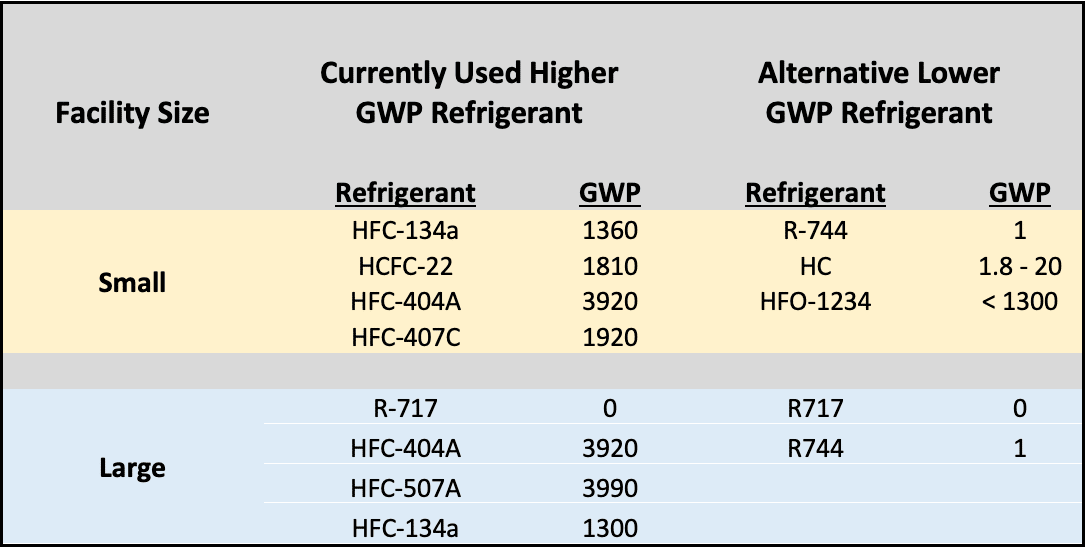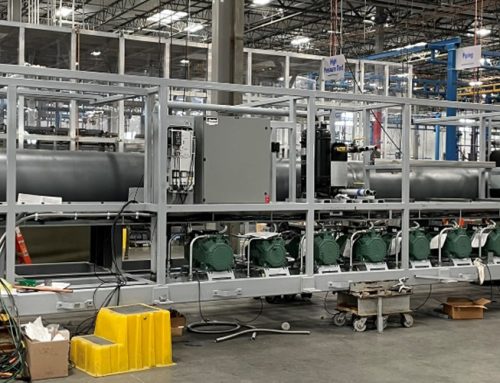Which Refrigerants Are Typically Used in Industrial Cold Storage Applications?
Hillphoenix understands that refrigerant selection is an important issue in terms of environment, safety and sustainability. Ammonia, CO2 and HFC/HFO refrigerants are the most common types used for industrial Cold Storage refrigeration systems. Through an intricate system of specially designed pipes, these gasses are compressed, transported, modified, and distributed to create the cooled air that the storage facility needs.
Within the food industry most refrigerated/freezer warehouses use direct expansion refrigeration systems. Direct expansion systems consist of two heat exchangers (a condenser and an evaporator), a means to pump and raise the pressure of the refrigerant (compressor), an expansion device, plus associated control devices, storage vessels and safety devices. In larger plants, pumped recirculation systems are common, often operating using ammonia (R717). In this system, the refrigerant is contained in a large vessel termed a ‘surge drum’ and pumped or fed by gravity to the evaporator(s).
Although many cold stores currently operate using ammonia as a refrigerant, which has negligible GWP but is mildly flammable and toxic, the industry is increasingly looking at “lifetime” system costs and improved safety which often favor systems that may have higher initial costs but have lower energy costs, lower total cost of ownership (TCO) and are safer to operate, such as CO2 (R744).
In some instances, cascade systems are employed. The most common CO2 cascade system utilizes CO2 on the low-temperature side operating below its critical temperature and ammonia on the high-temperature side.
A renewed look at these alternative natural refrigerants is being driven by the imminent phasing out of synthetic refrigerants due to their adverse environmental impact. The progress made in the technology and design of CO2 loops has increased the use of full CO2 refrigeration systems (such as the Hillphoenix CO2 booster system) utilizing R744 refrigerant. It is increasingly common to find these systems employed in both freezing and low-temperature warehouses.
With the Hillphoenix team of experts trained to handle CO2 for industrial refrigeration, businesses working together with Hillphoenix can adopt CO2 systems safely and efficiently and the industry could realize huge gains moving forward.
Smaller, existing Cold Storage facilities still often operate on HCFC or HFC refrigerants while natural refrigerants (primarily CO2, R744) are rapidly gaining in popularity as the refrigerant of choice with newer facilities. Hillphoenix covers the gamut of needs with offerings of both synthetic refrigerant parallel rack systems and the full Hillphoenix CO2 booster system.
In some applications, Cold Storage facility chillers may be employed using a sustainable secondary refrigerant (e.g. glycol) that is cooled by a primary, centralized refrigeration system utilizing any one of a variety of primary refrigerants (synthetic or natural), and then pumped to the cold store to extract heat.





